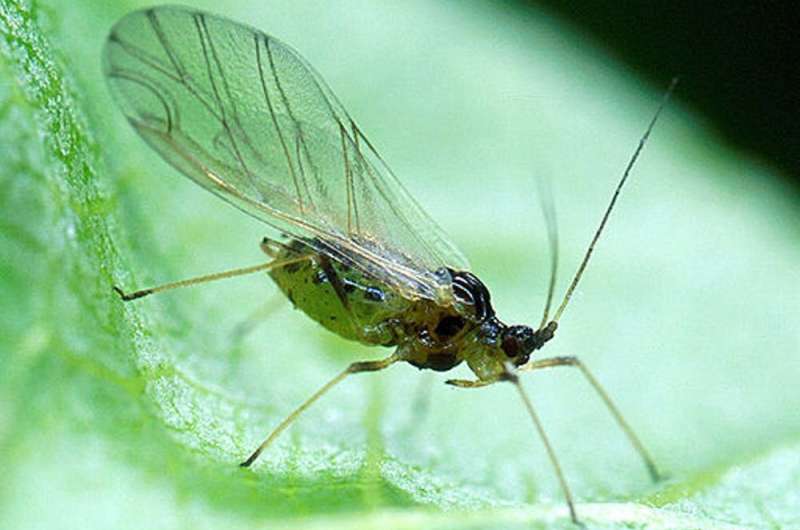3 ways insecticides can be counterproductive in agriculture

Pesticides are not new and are definitely not a human invention. Plants and other microorganisms have used chemicals to defend themselves from other organisms for hundred thousands of years.
Take, for example, walnut trees. Their that is secreted into the soil and inhibits nearby plant growth. This ensures the walnut tree has all the nearby nutrients and water for itself.
Plants also produce insecticides. Nicotine is the most famous example, produced by plants in the solanaceae family, including tomatoes, potatoes and, of course, tobacco. Many plant-eating insects avoid tobacco plants because nicotine is a .
Humans have replicated this natural chemical warfare to produce pesticides that have become essential for agriculture. But insecticide use also raises concerns about their impact on non-target species such as bees, or their indirect effect on birds, which eat a lot of insects.
Scientists who study insects and how they adapt to pesticides are discovering that some insecticides can make pests stronger or that the plant itself might even become under greater attack from other pests. Finding solutions is important both for preserving biodiversity and agriculture.
When a farmer uses insecticides, they are aware of beneficial effects on their fields but they need also be aware of the potential negative impacts.
What doesn't kill you makes you stronger
A pesticide can provoke a resurgence of the target pest in the days, weeks or months that follow its application. Insecticides must be applied at lethal concentrations and sometimes several times during the pest's lifecycle to be fully effective.

At sub-lethal concentrations, a pesticide can, in fact, . For example, when imidacloprid (an insect neurotoxin from the neonicotinoid family) is applied at sub-lethal concentrations, it can .
Even worse, a . Pesticide resistance makes these chemicals useless or even detrimental. This is the case for the insecticide-resistant strain of maize weevil, which .
Outbreaks on repeat
Insecticides can be selective —targeting a particular insect —or act on a range of pests (broad spectrum). Broad-spectrum insecticides are widely used, but can have detrimental adverse effects such as disrupting a pest's natural enemies.
In these cases, a few weeks after the pesticide is applied, the same pest will . These phenomena have been identified on many crops, including , and , but they're difficult to study because there are so many different factors involved.
Some researchers have estimated that an early season pesticide treatment on cotton for lygus bugs can add for a subsequent late-season pesticide application because the pest's natural enemies are depleted.
The sensitive plant
Some pesticide manufacturers now coat the plant seeds with pesticide, so that the plants take up the pesticide in their organs and become toxic to agricultural pests. This has become a very popular way to protect annuals such as wheat, soybean or corn.
But when a plant becomes resistant to some pests, it can also become more sensitive to others. The best documented example is the use of neonicotinoids on , , and the rise of two-spotted spider mite outbreaks. Spider mites are not susceptible to neonicotinoids and thrive on these crops much more compared to the untreated ones.
Without a doubt, . On the other hand, there are non-chemical options that can be used as alternatives or in addition to pesticides.
Insecticide alternatives
There are opportunities to reduce pesticide use, and scientists, like myself, work on many sustainable alternatives. A recent study highlighted that of the neonicotinoids used in agriculture could be replaced by non-chemical pest management. Among many others, an amazing called Jena is gathering researchers to see if bringing more plant diversity to the field increases resilience when compared to our mono-cultural agricultural systems.
Several new technologies are under development that could help reduce pesticide use. For example, cameras can detect the by plants during a pest outbreak. These warning signals can help farmers detect pests sooner and lead to a better, more efficient treatment.
Biotechnology can also help. Genetically modified crops have , but new techniques such as CRISPR-Cas9—a precise genetic tool able to change small parts of the genome—can, if used wisely, be . For example, a plant can be designed to .
Under the current agricultural model, pesticides are almost essential to provide sufficient food to the global population. But there are alternatives, and buying food from farmers that have stopped or limited pesticide use is one way to support an agricultural transition away from pesticides.
Provided by The Conversation
This article is republished from under a Creative Commons license. Read the .![]()


















